These beautiful longhaired cat breeds are ready for their close-up
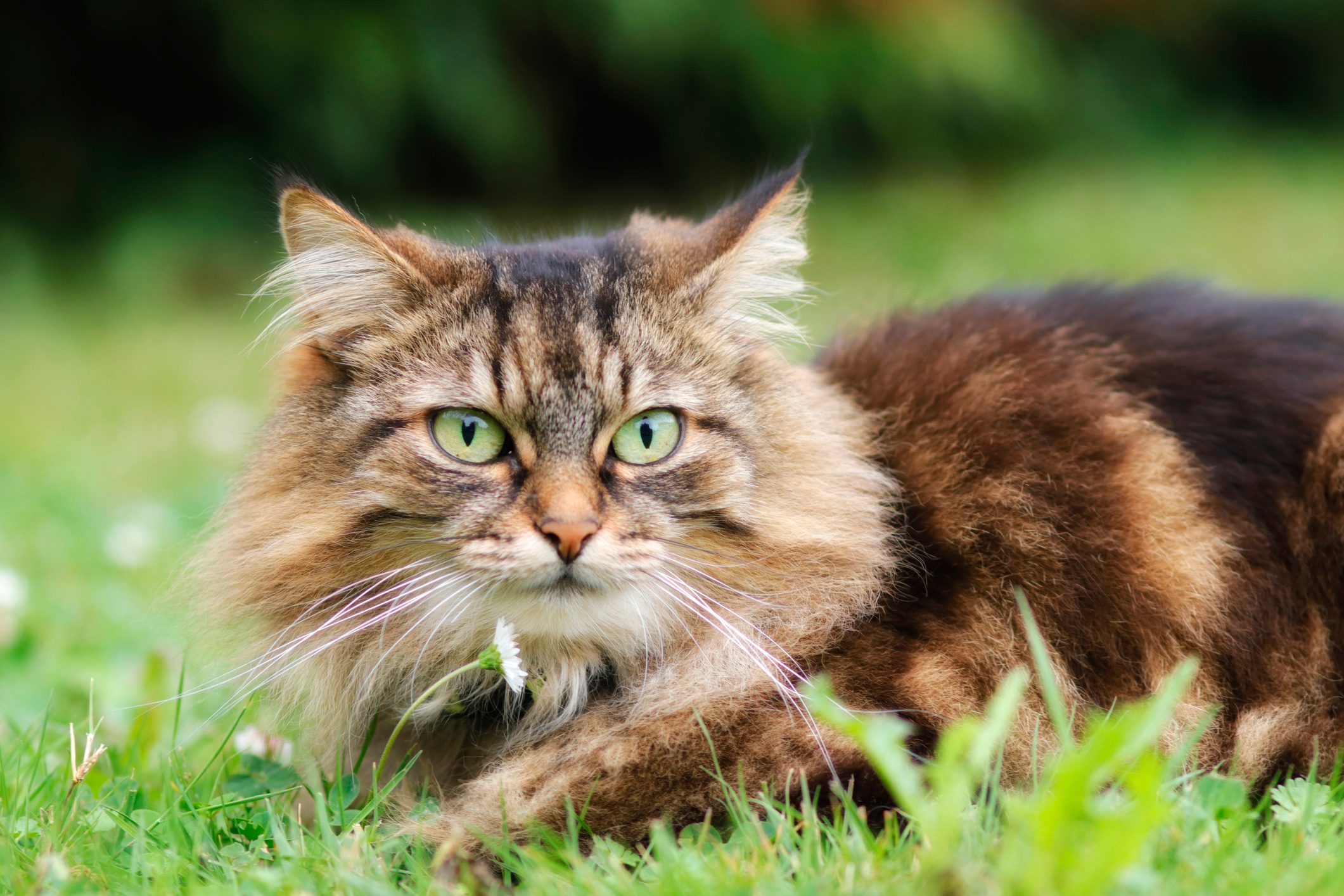
17 Longhaired Cat Breeds That Have Seriously Impressive Locks

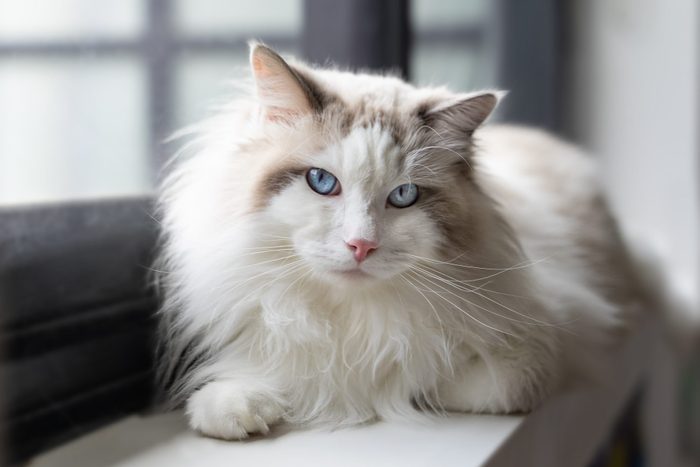
Ragdoll
With its silky long coat and cuddly demeanor, the Ragdoll is one of the most popular of the longhaired breeds. “They’re big, fluffy beautiful cats,” says Keiger. Because all Ragdolls have the colorpoint gene—meaning that the body is lighter in color than the head, legs and tail—they all also have striking blue eyes. And they’re known for their exceptionally sweet and docile personalities (as well as a high price tag).
Developed in California in the 1960s, the Ragdoll quickly won the hearts of cat lovers around the world. “They were our No. 1 cat for a number of years, mainly because of Chinese registrations,” says Keiger. But they’ve become a huge hit here at home too. Their gentle natures makes them great with kids and other pets, and their lack of a dense undercoat means they are relatively low-maintenance for a longhaired cat breed. Just a quick comb-out once or twice a week will keep their long locks looking their best.
While generally healthy, Ragdolls have been prone to a genetic heart condition called hypertrophic cardiomyopathy, but responsible breeders now routinely screen for the gene that causes it and have removed carrier cats from the breeding pool.
| Breed overview | Ragdoll |
| Height | 9–11 inches |
| Weight | 10–25 pounds |
| Life expectancy | 12–17 years |
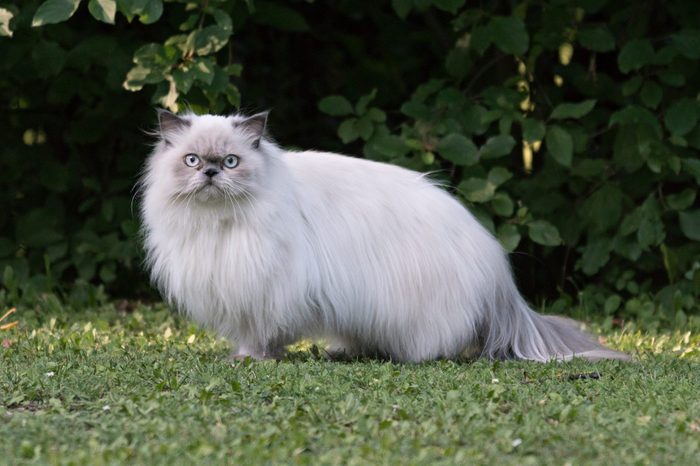
Persian
Pretty as can be, Persian cats have been a much-loved longhaired breed for centuries. “When people think of a longhaired cat, they generally think of a Persian,” says Keiger.
Persians are known for their ultra-long, luxuriously silky coats, huge round eyes and short, almost flat muzzles. The result is an exceptionally beautiful cat, but that beauty isn’t low-maintenance. Persians require daily combings and occasional baths to keep all that luxe fur looking its best. (Word to the wise, read up on how to bathe a cat without getting scratched.) They also often need the fur around their eyes wiped down to prevent staining.
True to their name, the breed traces its roots back to Persia (now Iran), but it has been a top breed in the U.S. since the CFA was founded in 1906. (The glamorous Persian came in at No. 3 on the CFA’s ranking of most popular cats for 2025.) That’s because Persians are way more than just good looks. They have equally alluring personalities, and they’re quiet, well-mannered and friendly. “Persians are very sweet and affectionate cats,” says Keiger. “I loved living with a Persian.”
While the Persian’s flat face makes it susceptible to excessive tearing and respiratory issues, responsible breeders have been working to resolve those issues with selective breeding. “I had a Persian for 10 years, and she had absolutely no trouble breathing,” says Keiger.
| Breed overview | Persian |
| Height | 10–15 inches |
| Weight | 7–12 pounds |
| Life expectancy | 15–20 years |
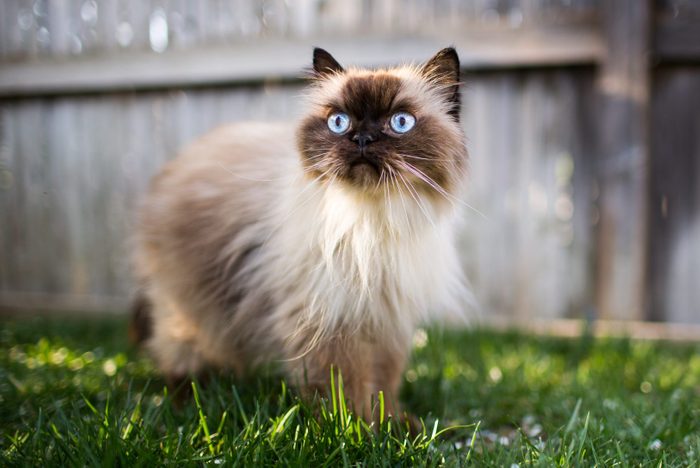
Himalayan
Love the look of Persian cats but wish they came in that striking colorpoint pattern like Siamese cats? Good news! They do—they’re just called Himalayans. Developed in the 1950s, Himalayans have the same long locks and sweet, smushed faces as the Persian, but with colorpoint coloring on their head, legs and tail. “And because they’re pointed, they have those big blue eyes,” says Keiger.
While the International Cat Association recognizes Himalayans as a separate breed, the CFA has kept them as a division of the Persian because the cats are so similar: “Their personalities are identical,” says Keiger. And like the Persian, Himalayans are known for being gentle, people-oriented and affectionate—and a little bit high-maintenance. Himmys, as they’re affectionately known, need daily comb-outs and regular baths.
And as with the Persian, the Himalayan’s short muzzle can increase the risk of excessive tearing and breathing issues. And make sure to check with your breeder and vet to see that the cat has been checked for polycystic kidney disease (PKD) and progressive retinal atrophy (PRA), two genetic conditions that have afflicted the breed.
| Breed overview | Himalayan |
| Height | 9–12 inches |
| Weight | 7–12 pounds |
| Life expectancy | 9–15 years |
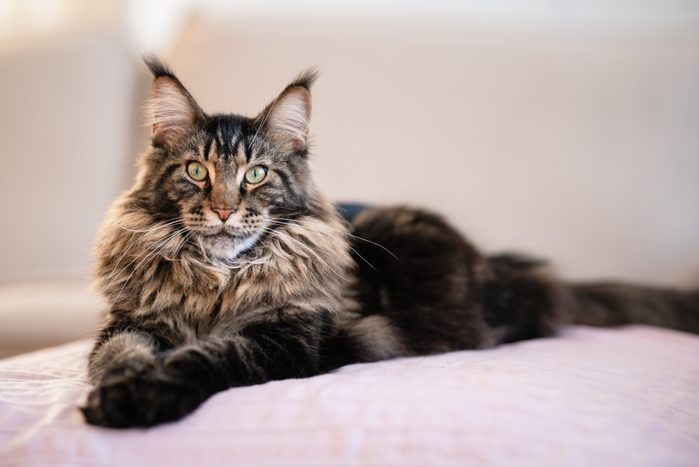
Maine Coon
The CFA ranks this homegrown stunner as the most popular pedigreed cat in the U.S., and it’s easy to see why. Maine Coon cats are majestic in stature (they top the list of the largest cat breeds) and kitten-like in personality. “We call them the gentle giants,” says Keiger.
The breed is known for its thick, flowing coat—the better to protect it from frigid New England winters—and adorably tufted ears and toes. They are super smart and notably curious, which means there is no type of shenanigan they won’t get into. But they’re also a breed that is easy to train to play fetch and even to walk on a harness and leash. Maine Coons are loyal and loving, making them great family pets despite their size.
Those dense, shaggy coats do need combing a couple of times a week, but you’re off the hook for baths, as the Maine Coon handles that itself. Maine Coons are generally quite rugged and healthy cats, but they can be prone to hip dysplasia and hypertrophic cardiomyopathy, so make sure your breeder or vet does the appropriate screenings.
| Breed overview | Maine Coon |
| Height | 8–16 inches |
| Weight | 10–25 pounds |
| Life expectancy | 10–13 years |

Norwegian Forest Cat
Known as the Skogkatt in its homeland of Norway, the Norwegian Forest Cat was once believed to be a gift from the gods. And while that may be legend, there’s definitely something divine about this gorgeous breed with its flowing fur, thick ruff and dramatically plumed tail. “They’re absolutely beautiful,” says Keiger. “It’s a very distinct look.”
A large kitty with a beefy build, Norwegian Forest Cats were bred in harsh, snowy climates, and their fur reflects that. They have a dense undercoat topped by a silky, water-repellent overcoat, with lots of insulating ruff around their neck and chest. “Think about what you would need to survive a Norwegian winter,” says Keiger. “You’d need a really thick coat that’s water repellent against the snow and rain and the damp. And that’s what they’ve got. It’s really pretty amazing.”
Norwegian Forest Cats are known for their happy, playful and spirited personalities. They’re independent in nature—so don’t expect a lap cat with this breed—but they do love their families and want to be a part of whatever is going on in the home. And grooming is surprisingly simple, given the abundance of fur. No baths required—regular comb-outs will keep that magnificent coat mat- and tangle-free.
Overall, Norwegian Forest cats tend to be rugged and healthy. The breed has had a history with a couple of hereditary health conditions—hypertrophic cardiomyopathy and glycogen storage disease—but breeders have worked to screen carrier cats from the breeding pool.
| Breed overview | Norwegian Forest Cat |
| Height | 9–12 inches |
| Weight | 12–16 pounds |
| Life expectancy | 14–16 years |
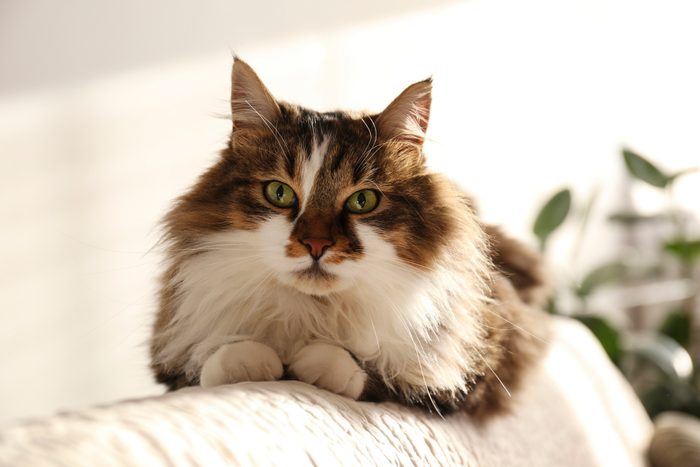
RagaMuffin
RagaMuffin cats are one of the newest longhaired breeds on this list. They originated in the United States in the 1990s as a variation on the Ragdoll. “People wanted a cat that was similar to the Ragdoll as far as personality, but that came in a variety of colors and patterns, not just color-pointed,” says Keiger. If it’s a genetically possible coloring pattern, “there’s a RagaMuffin that will have it.”
Both Ragdolls and RagaMuffins are large cats, and their personalities are nearly identical: super gentle, loving and loyal. In essence, they’re quintessential lap cats. “They are bred to be sweet,” says Keiger, and they succeed on every level.
A RagaMuffin’s fur tends to resist tangles and mats, so grooming is easy: Quick comb-outs once or twice a week will keep them looking their best. Because RagaMuffins are still relatively new, details of the breed are still emerging. But they are generally healthy cats that make great family pets.
| Breed overview | RagaMuffin |
| Height | 10–15 inches |
| Weight | 10–20 pounds |
| Life expectancy | 12–18 years |
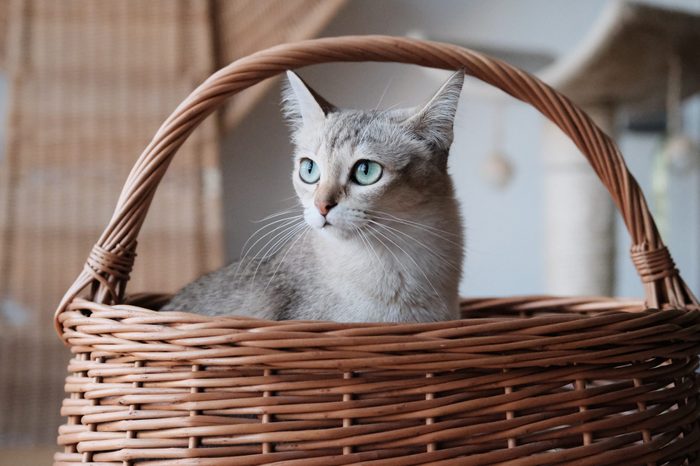
Burmilla
Talk about a happy accident! Back in 1981, an unaltered male Chinchilla Persian crossed paths with a lilac European Burmese female. The resulting black-shaded silver kittens were so adorable that—voilà!—a new breed was born.
With their sparkling shaded silver coats—pale at the roots and tipped with color—and dazzling green eyes lined in black, Burmilla cats will stop you in your tracks. And their people-oriented personalities are just as appealing. “They are absolutely beautiful and sweet cats,” says Keiger. “They get their coats and eyes from the Persian. And from the European Burmese they get sweetness—plus a little bit of mischief.”
Burmillas (which also come in a shorthaired version) are smart and inquisitive, with a laid-back manner and a great love of play. Because both Persians and European Burmese are known for being affectionate and friendly, Keiger says the Burmilla “doubled-down on sweet.”
While still a relatively rare cat breed, Burmillas are growing in popularity, in large part because they are both beautiful and easy to care for. Those long locks don’t even require special grooming, just regular comb-outs to remove loose hair and keep it from matting.
| Breed overview | Burmilla |
| Height | 10–12 inches |
| Weight | 8–12 pounds |
| Life expectancy | 7–12 years |
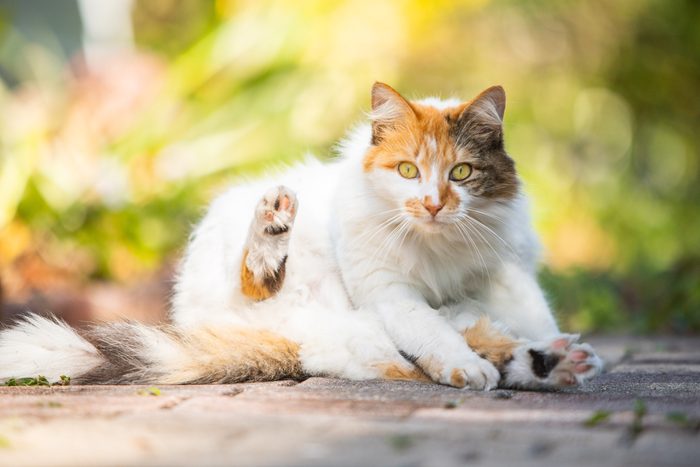
Turkish Van
Sadly, these longhaired lookers are getting harder and harder to find. “There are just not that many Turkish Van breeders anymore,” says Keiger. “Which is really too bad, because they are beautiful cats.”
Turkish Vans are large white cats with color—black or red—restricted to the head and tail (and possibly one spot on the body) in what has become known as the Van pattern. They have large mesmerizing eyes of amber or blue, or sometimes one of each, and a soft, cashmere-like coat. But don’t mistake these beauties for delicate creatures. Turkish Vans are considered one of the most dog-like of the cat breeds. They even love to splash around in water!
An ancient, natural breed, the Turkish Van traces its roots back to the Lake Van region of eastern Turkey. They first made their mark on the modern world in the 1950s, when a pair of photographers brought them to England and changed their name from “Turkish Cat” to “Turkish Van” to differentiate the breed from the Turkish Angora.
Although Turkish Vans don’t generally like to be held (“They can be a little aloof,” says Keiger), they are generally healthy and easy to care for, with no special grooming required. And they make great pets: Vans love their people, and they love to play. They are also known for being quite smart, so think twice before you hide that treat bag. They will find it.
| Breed overview | Turkish Van |
| Height | 10–14 inches |
| Weight | 10–20 pounds |
| Life expectancy | 7–12 years |

Turkish Angora
Turkish Angoras are the oldest known longhaired breed of cat, and one of the most popular. They have a reputation for being among the most socially outgoing and affectionate felines out there. And they’re quite beautiful, with a long, dense and silky coat that extends all the way to the tip of their very long plumed tail. “They are a lively, active, intelligent cat [that’s] long and elegant,” says Keiger. “And I love their tails. They always remind me of those big, poofy ostrich feather boas.”
If you’re thinking about bringing one of these sweet floofs home, know that Turkish Angoras tend to be very smart and people-oriented—and a little mischievous. “They are just full of energy and bouncing off the walls,” says Keiger. “Turkish Angora folks will say: ‘If you’re missing your cat, just look up,’ because they like to jump.” In other words, this is a high-energy breed. “They’re perfect for active households and those with dogs, but if you value all your tchotchkes, it’s probably not the right breed for you.”
Turkish Angoras come in a wide variety of colors and patterns, but the most popular is white. And because white cats are prone to deafness (especially white cats with blue eyes), you’ll want to have your kitten’s hearing tested. On a positive note, the breed’s single-layer coat is not prone to matting, which makes grooming these longhaired beauties a cinch.
| Breed overview | Turkish Angora |
| Height | 8–10 inches |
| Weight | 5–10 pounds |
| Life expectancy | 15–18 years |

Scottish Fold
You may be more familiar with the shorthaired version of the Scottish Fold, but this cutie comes in a longhaired variety too. Both are known for their round heads, big eyes and ears that fold downward. And both look a little like fluffy owls. “I happen to adore longhaired Scottish Folds,” says Keiger. “With those ears, those enormous eyes and all that fur … they’re just so striking.”
As their name suggests, Scottish Folds trace their story back to Scotland. A farm cat named Susie was born with a naturally occurring mutation that caused her ears to fold downward. Susie passed on the mutation to her kittens, but not all Scottish Fold cats actually have folded ears. Because folded-ear cats are only bred with straight-ear ones—for the health of the cat, says Keiger—only about 50% of Scottish Fold kittens develop the signature downturned ear. (Not to worry: Straight-eared Scottish Folds also compete in the cat-show ring and, of course, make great pets.)
But it’s not just about the ears with these coveted kitties. Scottish Folds tend to be some of the sweetest cats on the planet. If you’re thinking of getting one, note that the gene mutation that causes the folded ear can also affect cartilage elsewhere in the body. So watch for signs of arthritis, and talk to your vet if your cat is showing any signs of pain or stiffness.
| Breed overview | Scottish Fold |
| Height | 8–10 inches |
| Weight | 6–13 pounds |
| Life expectancy | 12–16 years |
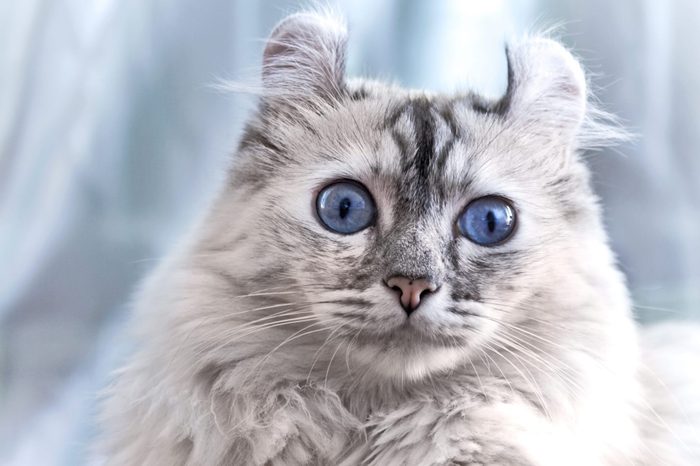
American Curl
With soft, flowing locks and ears that curl back and away from their adorable faces, American Curl cats always look a little surprised to see you. But never doubt it: There’s no place they’d rather be than at your side. “They’re very sweet and affectionate,” says Keiger. “They’re very people-oriented, and they love to play.”
American Curls, which can also be short-haired, come in many colors and patterns. Their signature ears are the result of a natural gene mutation, but—unlike the Scottish Fold—that mutation doesn’t seem to affect any other part of their body. There are no breed-specific health issues to worry about, and they differ from their unique-eared cousins in other ways too. “They are more active than Scottish Folds,” says Keiger. “They’re longer, and a lot more graceful. And they have a little bit of mischief to them too.”
As with all longhaired cats, American Curls do need some grooming. But because they have a minimal undercoat under all that silky fur, they are pretty low maintenance. A good combing once or twice a week will keep them looking great.
| Breed overview | American Curl |
| Height | 9–12 inches |
| Weight | 5–10 pounds |
| Life expectancy | 12–16 years |
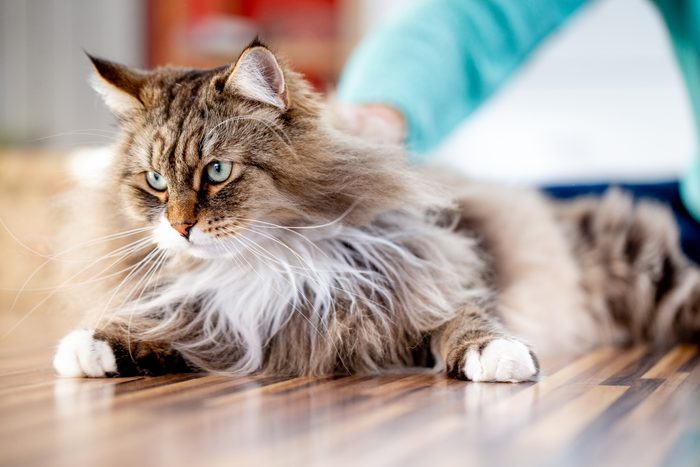
Siberian
This large, longhaired feline isn’t just drop-dead gorgeous, it’s widely considered one of the smartest cat breeds on the planet. “The story has it that they used to perform in the Russian circuses back in the 1900s,” says Keiger. “They’re very smart and agile, and they can easily be taught tricks.”
Considered a national treasure in their homeland, Siberian cats were often featured as the heroes of Russian fairy tales. But their real-life work was more mundane: keeping down the rodent population. That thick triple coat was a defense against the harsh Russian winters, so be forewarned: Today’s Siberians still have that coat, and they shed much of it during the summer months. Frequent grooming sessions are required to keep mats and tangles at bay.
While resilient, strong and independent, the Siberian also has a softer side. They are gentle with kids and other animals, and they love to be around their people. In fact, these easygoing beauties are known for becoming so attuned to their owner’s moods that they’ve developed a reputation as excellent emotional support and therapy pets.
| Breed overview | Siberian |
| Height | 10–12 inches |
| Weight | 5–12 pounds |
| Life expectancy | 8–10 years |

LaPerm
With their soft waves and springy ringlets, these curly-haired cuties look like they just stepped out of a hair salon. “They have a distinctive curly coat that’s different from any other breed,” says Keiger. “It’s soft and springy and light to the touch. I always think it looks a little like cotton candy.”
The breed has only been around since the 1980s, after a curly-haired kitten was born to a tabby cat on an Oregon farm. After a couple of subsequent litters of curly-haired kittens, the owner realized she had witnessed the birth of a new breed. The were recognized by the CFA in 2000.
Today, LaPerm breeders describe the cats as inquisitive, affectionate and people-oriented. But most cat enthusiasts have never seen one in person. “There are only one or two people in the U.S. who are working with them,” says Keiger, though she’s seen them in Japan, Australia and New Zealand. And they’re beautiful, Keiger adds: “A good LaPerm is very striking.”
| Breed overview | LaPerm |
| Height | 6–10 inches |
| Weight | 8–10 pounds |
| Life expectancy | 10–15 years |
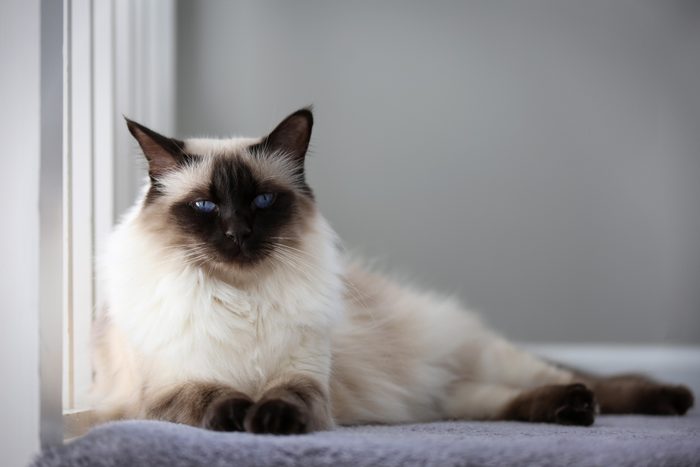
Balinese
Though its name sounds exotic, the Balinese was actually born right here in the USA in the 1950s. The breed was developed by two Siamese breeders, who fell in love with some longhaired kittens and decided to lean into the variation. “The Balinese is just a longhaired Siamese,” says Keiger. “It has the same long slinky body, refined boning, long tail and large ears, but with a different coat length.”
The Balinese mimics the Siamese personality as well. Balinese kitties are smart, social creatures who love hanging out with their owners. “They want to be with you,” says Keiger. “In fact, they’ll insist on being with you. They will worm their way into your lap, inch by inch.” They are also unrepentant chatterboxes. “These are talkative cats,” Keiger adds. “They have opinions, and you’re entitled to them.”
While not as big and fluffy as some other longhaired breeds—these cats are really more semi-longhaired—the Balinese boasts a coat that is soft and silky and doesn’t require a lot of upkeep. It rarely mats and just needs combing every week or so.
| Breed overview | Balinese |
| Height | 8–11 inches |
| Weight | 8–15 pounds |
| Life expectancy | 15–20 years |

Birman
Known as the sacred cat of Burma, the Birman is all kinds of adorable. Just check out that flowing colorpoint coat, cute white paws and mesmerizing peepers. “These guys have the most expressive blue eyes ever,” says Keiger.
And as if its good looks weren’t enough, the Birman is gentle, sociable and people-oriented. Their laidback personality makes them a perfect companion for adults and kids alike. “They want to be with you,” says Keiger. “They have an incredibly sweet nature.”
Birmans are generally healthy, and their grooming needs are minimal despite that luxe-looking coat. They actually have no undercoat to mat and tangle, and unlike some other longhaired breeds, the Birman’s coat will not mat or curl when wet, according to Keiger.
| Breed overview | Birman |
| Height | 8–10 inches |
| Weight | 10–12 pounds |
| Life expectancy | 13–15 years |
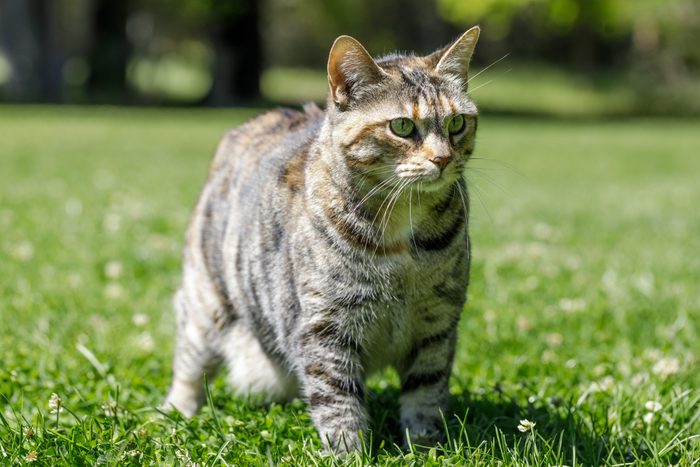
American Bobtail
Don’t be fooled by the name or that serious look in his eyes. The American Bobtail is no wildcat. Keiger says they just look wild, especially when they look off into the distance, which she refers to as a “hunting gaze.”
And that stealthy stare is not even the breed’s most unique feature. As their name implies, American Bobtails have tails that are about half the length of a normal cat tail—the result of a natural mutation first discovered in a feral cat in the 1960s. Instead of a long tail, they “just have a couple of joints, with a lot of skin around it and a fat pad,” says Keiger.
While American Bobtails also come in a shorthaired variety, it’s the ones with long flowing coats that seem the most like their wildcat counterparts. But they’re just lap cats in waiting. Bobtails are known for being smart, sweet and affectionate with their people. They’re good with kids and they love to play—particularly hunting games. Just make sure to give them plenty to do, as they’re happiest when they’re discovering new things to explore.
If you’re considering bringing a longhaired American Bobtail home, no need to worry about the grooming. A weekly brushing or combing is all these cats need to keep their rugged appeal.
| Breed overview | American Bobtail |
| Height | 9–10 inches |
| Weight | 7–16 pounds |
| Life expectancy | 13–15 years |
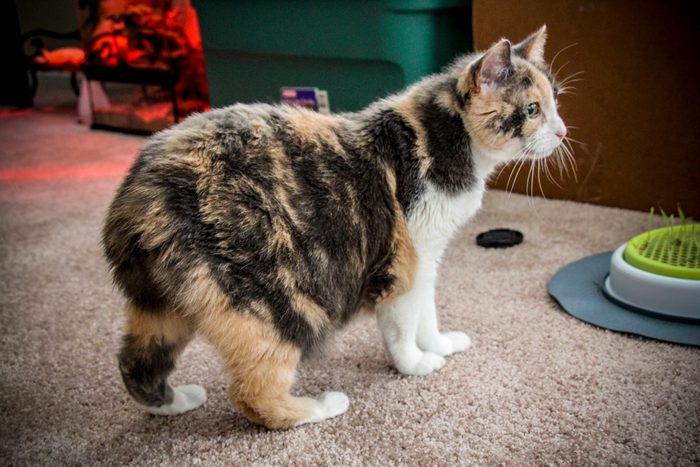
Manx
Once you check out the plush flowing fur, soft curves and round chubby cheeks on a longhaired Manx, you might not even notice the cat’s most famous feature: its lack of a tail. “It’s not just all about that bass,” jokes Keiger. “There’s much more to the Manx.”
Manx cats—which come in both long- and shorthaired varieties—trace their history to the Isle of Man in the Irish Sea. An ancient breed, they got their taillessness from a natural genetic mutation that spread through the island’s cat population over centuries. (Some Manx cats are born with tails or partial tails, but only tailless Manx compete in cat shows.)
Sometimes affectionally called “bowling balls with fur” because of their overall roundness, Manx cats are big, muscular cats with hind legs that are a little higher and more robust than other breeds, which helps with balance. “You haven’t seen anything until you’ve seen a Manx go running hellbent for leather across the floor and up a cat tree,” says Keiger. “It’s pretty impressive.”
Manx cats are loyal, deeply affectionate and eager for play, but they also need their space. “They’re not lap cats,” says Keiger. “But they want to be with you. They like to hang out in the same room as you do. They even like to play fetch.”
Despite their plush coats, longhaired Manx are easy to groom. Weekly combing or brushing is all they need. But if you’re thinking of bringing a Manx into your family, talk to your vet about Manx syndrome. The genetic mutation that causes Manx cats to be tailless can also cause some serious developmental disorders. Your breeder will need to screen for abnormalities before any kittens are placed.
| Breed overview | Manx |
| Height | 7–11 inches |
| Weight | 8–15 pounds |
| Life expectancy | 10–14 years |
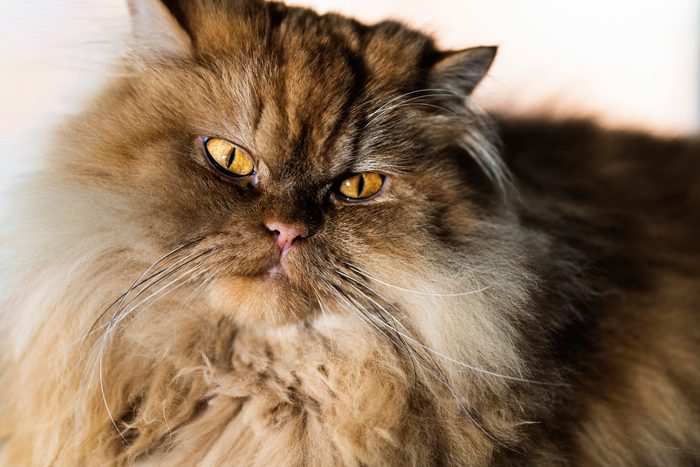
Tips for grooming longhaired cat breeds
Longhaired cat breeds typically require more grooming compared with short, medium or hairless cat breeds. Follow these tips for a healthy, pristine kitty:
- Groom from a young age, so they’re used to being brushed.
- Brush or comb daily to prevent knots, matting and tangles.
- Cut away matted fur or knots that do occur (there are special de-matting combs available).
- Use a wide-tooth comb or brush that’s made specifically for longhaired cat breeds.
- Trim fur around their hindquarters to prevent fecal matter from getting stuck in fur.
- Keep grooming sessions short, and stop if your cat is distressed. A nice treat after brushing can help them look forward to the experience.
- Consider professional grooming.
About the expert
|
Why trust us
At Reader’s Digest, we’re committed to producing high-quality content by writers with expertise and experience in their field in consultation with relevant, qualified experts. We rely on reputable primary sources, including government and professional organizations and academic institutions as well as our writers’ personal experiences where appropriate. We verify all facts and data, back them with credible sourcing and revisit them over time to ensure they remain accurate and up to date. Read more about our team, our contributors and our editorial policies.
Sources:
- Teresa Keiger, allbreed judge with the Cat Fanciers’ Association; phone interview, March 25, 2025
- The International Cat Association: TICA Recognized Breeds
- The Cat Fanciers’ Association: CFA Recognized Breeds
- Royal Society for the Prevention of Cruelty to Animals: “Grooming Your Cat”




















